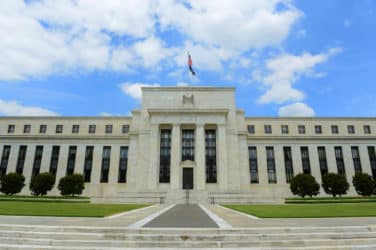Twenty-five or 50? Basis points, that is.
Last week the U.S. equity markets got what traders are saying was the final piece of the interest puzzle – U.S. jobs data which saw payrolls rise 235,000 – the second straight monthly gain – which translates into a near-100% market certainty that the FOMC will raise rates later this week. Expectations were for a rise of 188,000. Last week, futures pointed to an 85% to 90% chance of higher rates – and that was for a 25 bps hike.

Larry Peruzzi, Mischler Financial
But will Wednesday’s announcement push rates 25 bps higher or a more dramatic 50bps?
Larry Peruzzi, managing director, international equities sales/trading at Mischler Financial Group, told Markets Media that he hoped that the month of March does not go out like a bear, after coming in like bull. He noted how on March 1 the Dow, S&P 500 and Nasdaq composite all closed at record highs, but over the next 6 trading sessions the S&P declined on 4 of 6 days and had very small gains on the 2 other days. Furthermore, last Thursday the bull market celebrated its 8th year with gains of between 1bp and 8 bps in U.S indices.
“But after eight years markets seem to be both tired and excited,” Peruzzi said. “Valuations are starting to be questioned but expectation of job growth and tax relief has few ready to sell but an equally few are ready to jump in. So, markets feel as though we are currently in a stalemate.”
But now with Friday’s February employment report and its gains the market is pondering a higher-than-originally-thought interest rate hike, he added. This is backed up by last Monday’s Factory Orders data that exceeded expectations, Wednesday’s ADP employment change that outperformed estimates by a healthy 112K and Thursday’s import prices which showed inflation seems to be under control.
Trading on U.S. equity exchanges was reported at an average 6.76 billion shares for the week ended march 10, down from the 7.46 billion shares per day for the week ended March 3, according to Bats Global Markets data.
“Looking to this week investors will have plenty to digest. We get a good view on inflation with Tuesday’s PPI report for February and Wednesday CPI report for February. Wednesday’s retail sales figures will give us a clearer picture as to how much of the surge in household wealth has push through the economy,” Peruzzi said. “Fed Funds are actually pricing in a 100% probability of a rate increase.”
But Peruzzi didn’t rule out a larger hike. And neither did others.
According to CNBC reports, UBS upped its view to three rate hikes from two, and NatWest Markets went from two to four.
In other market news, Greenwich Associates reported that institutions are allocating their increasingly scarce resources to fixed income pursuits and technology. Why fixed income? Why not equities or options or foreign exchange?
The ramp up in fixed income spending is directly linked to the expectation interest rates will shift in the coming months and years. After years of low and steady interest rate policy, the Federal reserve has made it very clear that the day of ultra-low interest rates has come to an end – as current forecasts point to a hike in short term rates this month – the first increase since 2015. And future rate hikes are also likely, with many pundits calling for two more interest rate hikes in the next 12 months totaling at minimum, 75 bps.
Also, agency-focused brokerage Convergex published “Take Your Trump-erature,” a survey that found almost 74% of respondents think President Trump will have a positive impact on the financial markets while only 40% approve of the job he is doing thus far.
The survey, which was conducted from February 21, 2017 through February 24, 2017, garnered a record number of responses with some surprising results, according to Convergex.
Furthermore, the survey reported only 20% of the respondents expect the market volatility (as measured by the CBOE VIX index) to increase more than 25% over the next 4 years, revealing an ongoing complacency about possible dramatic market fluctuations.
“We were surprised at some of the survey findings regarding Wall Street’s sentiments of the financial markets while under President Trump’s watch,” said Eric Noll, Covergex CEO and President. “It is clear from the results that most of the respondents feel President Trump will have a positive impact on the near-term prospects of the financial market, even if they don’t necessarily agree with his overall vision for the country.”
Lastly, mid- and small-tier US-based asset managers should not think that they’ve dodged the MiFID II bullet, according to a recent discussion on a Security Traders Association open call.
“If you are a US manager that doesn’t have any physical presence in Europe, you are not in the regulation’s bullseye,” said Tom Conigliaro, managing director at IHS Markit Brokerage and Research Services. “But from a practical and competitive pressure situation, you could be.”
Under MiFID II, which goes into effect in January 2018, asset managers that fall under the directive’s mandate no longer will be able to pay for research from commissions. Instead, they will need to pay for research directly using their own balance sheet or via a research payment account funded by commission sharing agreements or a research fee charged to clients.
Implementing an RPA will require asset managers to track their interaction with their counterparties, assess the quality of the delivered research regularly, establish and allocate a research budget, and manage payments directly or through an RPA administrator.
This Week’s U.S. Economic Indicators of Interest:
| Monday | Labor Market Index |
| Tuesday | Redbook Retail Sales
Producer Price Index FOMC Meeting Begins |
| Wednesday | Consumer Price Index
Retail Sales Business Inventories Housing Index FOMC Policy Announcement |
| Thursday | Jobless Claims
Housing Starts Philadelphia Fed Business Outlook |
| Friday | Industrial Production
Consumer Sentiment Leading Economic Indicators |





